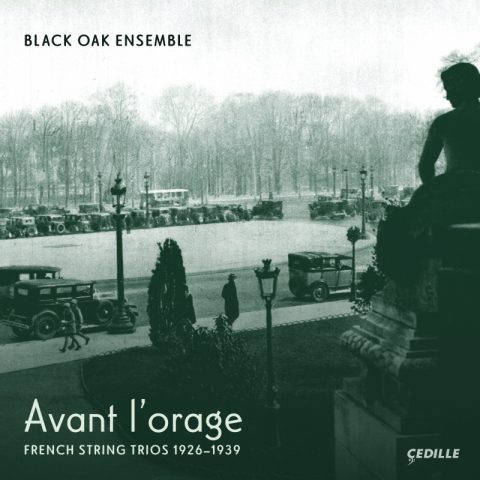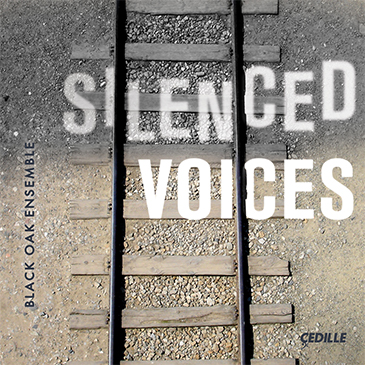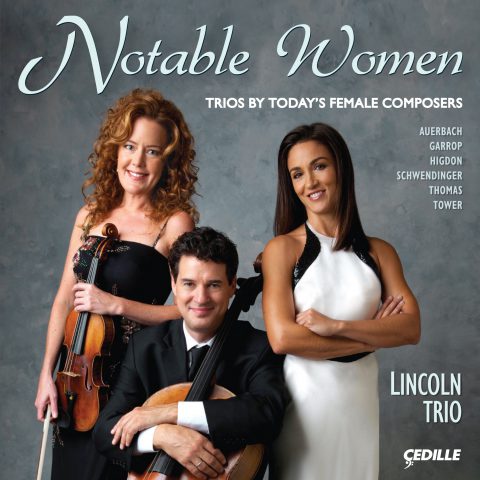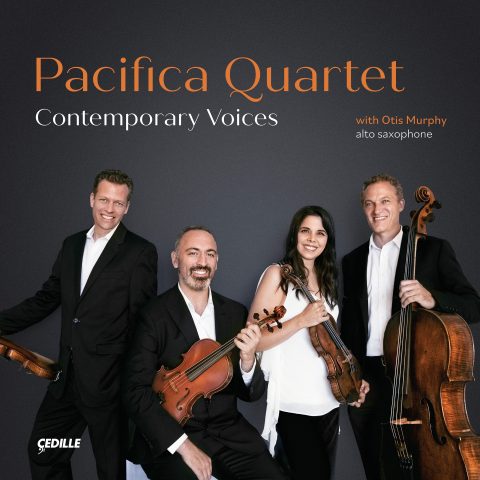Store
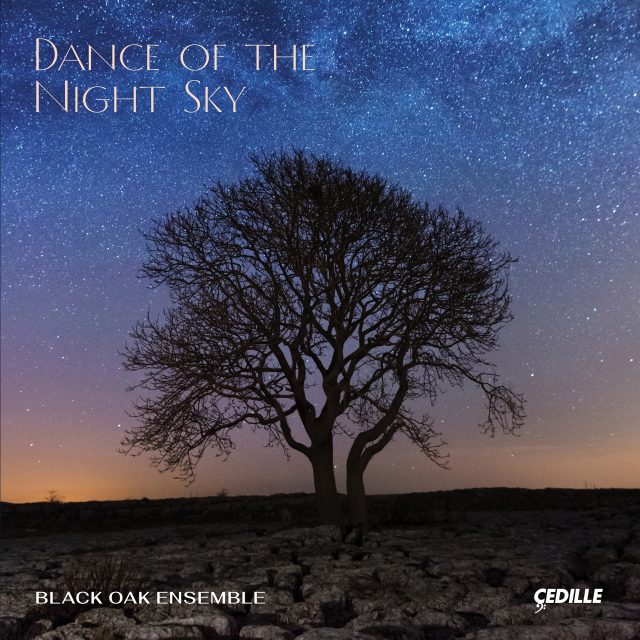
Dance of the Night Sky, Black Oak Ensemble‘s third album for Cedille, expands the boundaries of string trio repertoire by offering listeners a vibrant collection of contemporary works including four world-premiere recordings, all by British women composers.
Comprised of violinist, Desirée Ruhstrat violist Aurélien Fort Pederzoli, and cellist David Cunliffe, the Black Oak Ensemble has been praised for its “insightful, committed and masterful performances” (ClassicsToday) and “fierce eloquence” (London Times).
The album opens with the world premiere recording of Shirley J. Thompson’s Dance of the Night Sky, written for Black Oak Ensemble and premiered at the 2024 Cedille Soirée gala, showcasing the composer’s distinctive style, which has also marked historic occasions including Queen Elizabeth II’s Golden Jubilee.
The concept for the album was borne from an accidental Google search for “soccer” and “British composers,” leading to the discovery of Thompson’s Concerto for Football and Orchestra. This sparked a deeper exploration of string trios by British women and the idea to highlight the eight composers on the album, each bringing a unique voice to the string trio repertoire.
With vivid musical imagery ranging from a steam train station in Zimbabwe in Carol J. Jones’ bulawayo railway to the enigmatic poetry of Friedrich Nietzsche in Grace-Evangeline Mason’s Into The Abyss, I Throw Roses—both world premiere recordings — the album showcases a multigenerational array of commissions.
Sally Beamish’s The King’s Alchemist comprises four variations on the French folksong “L’Homme Armé” while exploring the story of John Damian, a European alchemist at the court of Scottish King James IV who donned wings to fly to France from Scotland’s Stirling Castle (he didn’t make it).
Dobrinka Tabakova’s Insight blends the voices of the string trio into a singular sound, evoking instruments such as the accordion and a brass fanfare.
Recently appointed Master of the King’s Music, Errollyn Wallen is one of the 20 most-performed living composers. Making Hay, in its world-premiere recording, takes her arrangement of J.S. Bach’s Prelude in E major from Book 1 of The Well Tempered Clavier and transforms it into a virtuosic showpiece for string trio.
Dance of the Night Sky was produced and engineered by James Ginsburg and Bill Maylone. It was recorded on September 9, 11, 13, 16 and October 10, 2024 in Mary B. Galvin Recital Hall at Northwestern University, Evanston, IL.
Dance of the Night Sky is made possible thanks to generous lead support from Gail Eisenhart Belytschko and F. Gary Knapp
as well as support from: Mary Alice and Craig Miller, Eileen and David Zampa, Barbara Englert Easterbrook and Frank Easterbrook, Rebecca and Arnie Klein, David Miller, Lynne and Ralph Schatz, and other guests at and supporters of Soirée Cedille 2024, the annual benefit for nonprofit Cedille Records, including:
Duffie Adelson
Tanja Kuivanen and Kevin Kaye
Cathy and Jim Landman
Martine Benmann and Ilya Levinson
Judy and Scott McCue
Margaret L. Moses
Maria Simon and John Taylor
Barry Wershil
Susie and Randy Williams
Diane Wood and Rob Sufit
Robert Young
Preview Excerpts
Shirley J. Thompson
Judith Weir
The Bagpiper’s String Trio
Dobrinka Tabakova
Carol J. Jones
Freya Waley-Cohen
Sally Beamish
The King’s Alchemist
Grace-Evangeline Mason
Errollyn Wallen
Artists
1: Black Oak Ensemble
2: Black Oak Ensemble
3: Black Oak Ensemble
4: Black Oak Ensemble
5: Black Oak Ensemble
6: Black Oak Ensemble
7: Black Oak Ensemble
8: Black Oak Ensemble
9: Black Oak Ensemble
10: Black Oak Ensemble
11: Black Oak Ensemble
12: Black Oak Ensemble
13: Black Oak Ensemble
Program Notes
Download Album BookletProgram Notes
Notes by Elinor Olin
The Black Oak Ensemble is on a mission: to expand and promote the repertory of new and exciting music for string trio. In this, their third album, the group has continued to develop and nurture the genre, exploring the music of today by commissioning two new works and presenting pieces by eight contemporary composers, four receiving their world premiere recordings. Dance of the Night Sky is a compendium of music by British women composers, each of whom writes in a unique voice while sharing a sense of British elegance and adventure. Independently of one another, the works call up otherworldly images and a persuasive ethereality, reflecting ancient times and faraway places. These compositions exploit the intricate balance among three virtuosic instrumental voices; in the words of featured composer Shirley Thompson, each “taking a turn leading the dance.” The Black Oak Ensemble continues to further the legacy of the string trio medium and share its deep passion for this incredible music.
Shirley J. Thompson (b. 1958)
Dance of the Night Sky
Commissioned by LeMarie O’Malley for the Black Oak Trio (2024)
WORLD PREMIERE RECORDING
Shirley J. Thompson has been described as a pioneering and dramatic composer
“with breathtaking vision.” Thompson has written for both large-scale and smaller,
less conventional ensembles, including symphonies, ballets, operas, concertos, and chamber music, as well as music for TV, film, and theatre. She has composed music to mark several royal occasions, including Queen Elizabeth II’s Golden Jubilee, and was one of 12 composers specially commissioned by King Charles III to compose orchestral music for the coronation on May 6, 2023. Thompson has also composed music to commemorate many other prominent national and international historical events, celebrating social change with music representative of diverse cultures and communities. She founded and has directed The Shirley Thompson Ensemble, a group of instrumental soloists, singers, dancers, visual artists, and poets for whom she has written groundbreaking compositions integrating contemporary classical music orchestration with improvisation, pop, world music, dance, and the spoken word.
Thompson strives to (in her words) “push the boundaries of traditional classical music forms and content, with the intention of creating diversity in contemporary classical composition and strengthening its audience reach.”
Dance of the Night Sky, written specifically for, and premiered (at the 2024 Soirée
Cedille gala) by, the musicians of the Black Oak Ensemble, begins with athletic and joyful rhythms the composer has likened to musical breakdancing. Opening with masterful counterpoint for the ensemble, Thompson makes literal the choreographic energy implied by the work’s title as the performers are directed to pluck pizzicato chords while simultaneously “stomping their feet loudly.” These energetic sequences of syncopated figuration return throughout the work, alternating with virtuosic solo dances for each instrument, beginning with the cello. The athleticism of these solos, jumping between intervals that span nearly the entire range of each instrument, is urged on by the others leaning in with syncopated commentary. The viola takes a turn and, after a variation of the opening material, the violin plays the inversion of the cello’s solo dance. The work closes with a rhythmic dance step recalled from earlier in the piece, as the ensemble hurtles in unison toward the end, punctuated by a final glissando-inflected foot stomp.
Judith Weir (b. 1954)
The Bagpiper’s String Trio (1985)
I. Salute
II. Nocturne
III. Lament, over the sea
Judith Weir is, above all, a musical storyteller. Many of her works are influenced by folk music traditions, especially their direct expression and sense of history. Intrigued by Gaelic legends since childhood, Weir often conveys a sense of the medieval in her music, incorporating open harmonies and textures that activate a sense of sonic time travel. The Bagpiper’s String Trio is one such historically inspired work, based on the life of James Reid, a bagpiper in the Jacobite (rebel) army of Bonnie Prince Charlie. Captured by the English in 1746, Reid was executed after a judge identified the bagpipes as a weapon.
Weir’s large-scale works include a significant number of operas and opera films, as well as works for orchestra and chorus, including commissions from major orchestras and internationally recognized soloists. Her chamber music ranges from numerous works spotlighting relatively neglected instruments (e.g., double bass, trombone, saxophone, piccolo) to more traditional configurations for strings, piano, and voices. In 2014, Weir was appointed to the royal post of Master of the King’s Music — a position she held until succeeded by Errollyn Wallen in 2024.
The Bagpiper’s String Trio starts with strident, insistent appeals by the three instruments, their harmonies recalling the Scottish martial heritage of bagpipes (which continued until World War I). Here, the more familiar drone sounds of the pipes are weaponized by the inflection of modern dissonance as the ancient sound of open fifths is combined with the sharp sound of tritones. Militaristic fanfare continues until it is tempered by the Celtic lilt of the viola’s melody in of the movement’s closing section.
The “nocturne” of the second movement’s title is decidedly not one of reassuring
serenity. Instead, this nocturnal world suggests a foray into darkness filled with
imminent danger. The dissonant harmonic world of the first movement continues, now with a cautious, nervous stealth, sempre sotto voce. As Scottish pianist Iain Burnside has noted, “Judith Weir’s Scotland is a cruel, dark place, suffused with sinister magic.”
The final movement, Lament, is narrated by the cello, with muted, ethereal commentary by violin and viola. The swaying, dotted-rhythm couplets of the cello’s melody incorporate the wide, open intervals of the first movement’s fanfare. The accompanying voices’ steadier rhythms and tremolos encourage the cello’s expression, which becomes increasingly more elaborate before returning to the initial swaying lament. As if disappearing into the mists of history, the music fades away with wavering echoes of the bagpipe’s open-fifth drone.
Dobrinka Tabakova (b. 1980)
Insight (2002)
Dobrinka Tabakova’s work has been described as “exciting, deeply moving” music with “glowing tonal harmonies and grand, sweeping gestures conveying a huge emotional depth.” Tabakova’s extensive catalogue includes music for orchestra and large vocal and string ensembles, stage and multimedia works (operas and film and dance scores), and chamber music for strings and winds. Her music has been inspired by historical architecture (e.g., Centuries of Meditations for choir, harp, and strings, celebrating the stained-glass windows of a 13th-century cathedral) and natural imagery. Tabakova’s music embraces the idea that music can lead us to uncharted territories, especially through engaged and imaginative listening.
Insight is a wide-ranging exploration of the technical and sonic capabilities of the
individuals, as well as the ensemble, to create an entirely new and different “instrument.” Tabakova says the title, Insight, is a prompt to listeners that imaginative visualization through sound is one of the most satisfying experiences music can offer. Tabakova exploits the sounds of string glissandos, calling for the ensemble to perform pianissimo sustained tones that slide into subtly shifting harmonies, coming to stasis on an open fifth. The ensemble sound slowly “wakes up,” as if from a dream state (as described by the composer), to emulate the expanding and deflating bellows of an accordion. Tabakova summons up the stratospheric extremities of the violin’s range in the work’s middle section before the mood shifts with a lively, virtuosic counterpoint, each instrument equally having its say. The piece ends with a return to the subtly shifting glissando harmonies and a sprightly suggestion of an accordion’s ability to encourage dancing.
Carol J Jones (b. 1993)
bulawayo railway (2016)
WORLD PREMIERE RECORDING
Carol J Jones is a composer of contemporary classical music, including chamber,
orchestral, and vocal music. Informed by scientific methods, her work deconstructs sounds to create lively compositions intended to highlight our evolving understanding of the natural world. Jones writes that bulawayo railway was inspired by and dedicated to her grandfather, who served as Station Master of the Bulawayo Railway Station in Zimbabwe. Incorporating transcriptions of sounds from Garratt steam trains used at the time, the piece explores events from her family’s experience there, reflecting the joys and challenges of living in a country that is constantly changing. Here, and in many of her compositions, Jones is keenly interested in the relationship between music and the physical world around us, directing our focus to sound as it reinforces our connection to nature.
bulawayo railway emerges from near nothingness as the viola plays an eerie tremolo sul ponticello (on the bridge of the instrument) to alter its sound. The violin enters in contrast, playing stronger, slightly louder tones before the cello begins a restless repetition of fast notes, all to create the ancient harmonies of open fifth intervals. The score’s performance direction calls for an intention to sound “Dirty, Heavy” as the repeated notes, now in all voices, build with inevitable momentum. The introduction of irregular, unpredictable accents and increasing dissonance implies a violence inherent to large, heavy machinery — or is perhaps an anticipation of forthcoming events. Each of the instruments plays double (and triple) stops encompassing wider and wider intervals, expanding to registral extremes and maximum dynamics. The piece ends ominously, with unpredictable fortississimo outbursts and without harmonic resolution.
Freya Waley-Cohen (b. 1989)
Conjure (2019)
Freya Waley-Cohen’s music has been characterized as “startling and compelling.” Her extensive catalog includes works for a variety of chamber ensembles and solo instruments, as well as large-scale orchestral and vocal genres. Waley-Cohen’s recent works suggest a fascination with myth and magic, bearing evocative titles such as Demon for orchestra (2023), Talisman for string ensemble (2020), Spell Book (a dramatic song cycle for soprano, mezzo, and mixed ensemble) (2020), and Naiad for octet (strings, flutes, piano) (2018). Waley-Cohen writes that, in composing Conjure, she was inspired by the idea and implications of a séance: “the word, originally from ‘sedere’ — ‘to sit,’ also means ‘a session,’ most commonly a meeting in which people talk to the dead. In folklore and mythology, the idea of three people facing each other, with their thoughts pointed towards one purpose, brings up images of magic and conjuring.”
Conjure is an otherworldly exploration of the many sound possibilities intrinsic to the string trio, especially drawing on the virtuosity of highly skilled musicians. From the outset, Waley-Cohen combines kaleidoscopic changes of dynamics with subtle contrasts of techniques, including sul tasto (bowing across the bridge to create a gentler, more ethereal tone), pizzicato, and harmonics (lightly touching the strings while bowing to produce an unearthly timbre). Much of the work is built on the combination of two motives played at the opening by the full ensemble. The semitones gradually expand to the medieval sounds of the open fourth and fifth — first in melodic outline, then concurrently in harmonics. The contrasting middle section offers a tempestuous juxtaposition to the shifting luminosity of the opening. Here we experience fast and aggressive counterpoint, as though each player is furiously working to activate a magic spell. The piece’s final section conveys simultaneous, contrasting experiences of time as the violin deconstructs
the ferocious incantation while the viola and cello effectively create the ancient sound of a harmonic drone, sometimes in collaboration, sometimes in harmonics as double stops. The violin is the last to murmur the spell and, with an echo of the opening motive, the conjuring ends.
Sally Beamish (b. 1956)
The King’s Alchemist (2013)
I. Cantus
II. Aqua Vitae
III. Pavana
IV. Avis Hominis
Sally Beamish started composing at an early age. She began her professional career as a chamber music violist before she moved to Scotland in 1990, where she focused exclusively on composition for 25 years, before returning to also playing in 2015. She has written extensively for orchestra, large vocal ensembles, and the stage. Her wide-ranging catalog of chamber music encompasses works for diverse ensembles, including four string quartets (with cellos doubling on crotales), a saxophone quintet, and works for narrator and string trio. She is known for her many concertos commissioned for renowned soloists and premiered by major international orchestras. Beamish returned to performing in 2015, when her daughter, luthier Stephanie Irvine, made a viola for her. She was recently appointed Composer in Residence with the Yehudi Menuhin School, where she mentors composers and performs her works with colleagues and students.
The King’s Alchemist was inspired by the story of John Damian, alchemist to the court of King James IV of Scotland (reigned 1488–1513). Damian’s promises to transform ordinary metals into gold may not have been fulfilled, but his attempts to fly to France from the ramparts of Stirling Castle (also unsuccessful) left a durable impression in history. Beamish’s tribute to Damian’s exploits takes the form of four variations on the hugely popular 15th-century melody, “L’homme armé” (The Armed Man). At the top of the early music pop charts, this catchy tune also provided the less-than-obvious compositional structure (the cantus firmus) for many serious compositions, including at least 40 settings of the Mass. It is exactly this cantus firmus technique that Beamish incorporates into the first movement, “Cantus,” a title that also designates a voice part in medieval polyphony. Here, the tune is characteristically obscured, handed off among each instrument’s sustained tones, and couched in double-stop harmonics that recreate the spare sounds of 15th-century music. The second movement, “Aqua Vitae,” suggests the elixir used as a catalyst for early metallurgical experiments, and also to fuel the ill-fated flight of King James’ alchemist. “L’homme armé” is presented here as an angular dance melody, punctuated with percussive accents that gradually become the focus of the texture. “Pavana” recalls the stately, dignified Renaissance dance, here performed in slow unison rhythms with an occasional solo melody ascending into pianississimo nothingness. The final movement, “Avis Hominis” (Bird Man), opens with a quote from the first movement, then is transformed to an aviary with twittering bird calls that become gradually more insistent before disappearing, as foreshadowed by the ascending melodies of the “Pavana.”
Grace-Evangeline Mason (b. 1994)
Into the Abyss, I Throw Roses (2018)
WORLD PREMIERE RECORDING
Grace-Evangeline Mason has been praised as a “supreme painter in sound” with a “keen ear for musical texture — from dreamy hazes of electronic sound to sumptuous choral writing.” Mason describes her works as ethereal sound-worlds often inspired by art, poetry, and literature, designed to guide listeners through a narrative journey. Her works list includes a chamber opera and choral music for sacred and secular settings, as well as orchestral works and chamber music for standard ensembles, but also pieces exploring instrumentations from saxophone quartet to solo trombone + electronics.
Mason’s Into the Abyss was inspired by Nietzsche: “You have overcome yourself: but why do you show yourself to me only as the one overcome? I want to see the victor: throw roses into the abyss and say, ‘Here is my thanks to the monster who didn’t succeed in swallowing me.’” (Posthumous Fragments, 1882–1883). These images are introduced by a yearning violin melody, unaccompanied until it is joined by sparse dissonances played by viola and cello. The melody is subsequently taken up by each instrument, with interpolations of emphatic rhythmic sequences and a section of gentle descending triplets intended to simulate falling roses. The work ends with an amalgamation of the opening melody with the rhythmic intensity heard earlier, leading up to a final fortissimo exclamation of defiance.
Errollyn Wallen (b. 1958)
Making Hay (2024)
Commissioned by Nova Linea Musica Foundation for the Black Oak Ensemble
WORLD PREMIERE RECORDING
Recently appointed Master of the King’s Music and named one of the 20 most-performed living composers, Errollyn Wallen has produced nearly two dozen operas and a large catalog of orchestral, chamber, and vocal works that are performed and broadcast throughout the world. Wallen’s music has been played at the opening ceremonies of the Paralympic Games and for royal celebrations including Queen Elizabeth II’s Golden and Diamond Jubilees. In a 2024 BBC interview, Wallen shared the motto of her band, Ensemble X: “we don’t break down barriers in music . . . we don’t see any.” In the same interview, Wallen cited her Desert Island book choice: a collection of music by Johann Sebastian Bach.
Commissioned by and written specifically for the Black Oak Ensemble, Making Hay inspires positivity — at least while the sun shines. The trio begins with the ensemble playing Wallen’s trio arrangement of J.S. Bach’s Prelude in E major from Book 1 of The Well Tempered Clavier. We are abruptly startled out of this 18th-century reverie and into the here and now by new material marked “fierce and impassioned,” as we are confronted by dissonant chords, repeated with fortissimo insistence. New, angular themes are layered in virtuosic exchange, with momentary respite provided by references to the initial Bach tune, now spiced with pugnacious harmonies. The optimistic opening melody returns in a new tempo, setting in motion a sprightly dance integrating the wide melodic intervals of the previous section. The trio ends on a nostalgic note, as the final bars of Wallen’s Bach Prelude transcription are reintroduced — and resolved this time, by Bach’s supremely comforting, final E major chord.
Dr. Elinor Olin is a professor at Northern Illinois University School of Music
and has a background in both music performance and music history.
Album Details
Producer James Ginsburg
Engineer Bill Maylone
Recorded September 9, 11, 13, 16 and October 10, 2024 Mary B. Galvin Recital Hall at Northwestern University
Cover © Getty Images
Graphic Design Bark Design
Publishers
Thompson: Dance of the Night Sky © 2024 Shirley J. Thompson
Weir: The Bagpiper’s String Trio © 1997 Novello & Company Limited
Tabakova: Insight © 2002 Dobrinka Tabakova, Valonius Press, Schott Music
Jones: Bulawayo Railway © 2016 Carol J Jones
Waley-Cohen: Conjure © 2019 by Birdsong Music
Beamish: The King’s Alchemist © 2013 Edition Peters
Mason: Into the Abyss, I Throw Roses © 2018 Boosey & Hawkes
Wallen: Making Hay © 2024 Errollyn Wallen
CDR 90000 237
